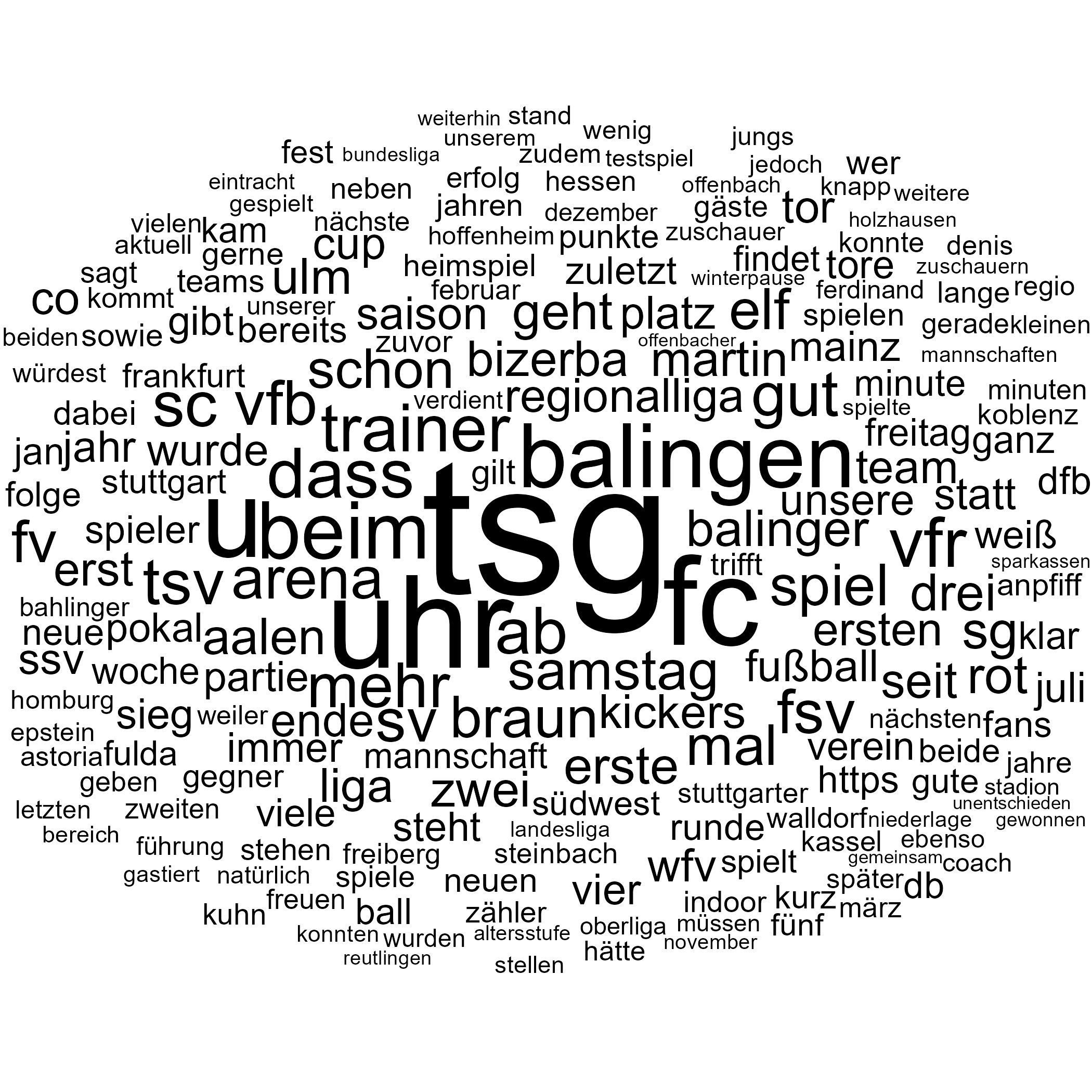Scrape the website of my local football club to get an overview of the content there.
The CSS selectors were extracted using techniques described in this wonderful tutorial. Mainly relying on the developer features of your web browser.
If you want to reproduce this analysis, you have to perform the following steps:
- Clone the repository
- Run
renv::restore() - Run
targets::tar_make()
The following libraries are used in this analysis:
library(ggwordcloud)
library(tarchetypes)
library(conflicted)
library(wordcloud)
library(tidyverse)
library(tidytext)
library(distill)
library(targets)
library(assertr)
library(polite)
library(httr2)
library(rvest)
library(fs)
conflicts_prefer(dplyr::filter)
Define where to look for the data:
tsg_url <- "https://www.tsg-fussball.de/"
We want to obey the scraping restrictions defined by the host.
Therefore, we introduce ourselves to the host and follow the
restrictions defined in ‘robots.txt’. This can be done using the bow
function from the polite package:
tsg_host <- bow(tsg_url)
These are the following for this example:
## <polite session> https://www.tsg-fussball.de/
## User-agent: polite R package
## robots.txt: 1 rules are defined for 1 bots
## Crawl delay: 5 sec
## The path is scrapable for this user-agent
Define the path, where the news article of this website can be found:
news_path <- "aktuelles"
Define the CSS selector, which identifies all elements on the websites that are links to news articles:
articles_css <- ".more-link"
We now want to find all news articles on the website:
- Modify the session path with ‘aktuelles’
- Scrape the website
- Look for elements representing article links by searching for CSS selector ‘.more-link’
news_links <- function(tsg_host, news_path, articles_css) {
host_news <- nod(tsg_host, path = news_path)
html <- scrape(host_news)
rows <- html |>
html_elements(articles_css)
rows |>
html_attr("href") |>
map(\(x) url_parse(x)) |>
map_chr("path")
}
paths_news <- news_links(tsg_host, news_path, articles_css)
In total we have 446 articles to scrape.
Look at some example paths:
## [1] "/2021/09/17/regionalliga-am-sonntag-geht-es-nach-grossaspach/"
## [2] "/2024/03/07/regionalliga-sonne-pur-und-der-garten-kann-warten/"
## [3] "/2021/12/22/vertragsverlangerung-martin-braun/"
## [4] "/2022/04/19/regionalliga-tsg-duepiert-titelkandidat-offenbach/"
## [5] "/2022/11/24/7336/"
We want to extract the content of every article. We are looking for the following parts of the post by searching for specific CSS expressions:
- Title defined by ‘.gdlr-blog-title’
- Lines defined by ‘.avia_textblock p’
news <- function(tsg_host, path_news, title_css, line_css) {
host_detail <- nod(tsg_host, path_news)
html_detail <- scrape(host_detail)
tibble(
title = html_element(html_detail, title_css) |> html_text2(),
line = html_elements(html_detail, line_css) |> html_text2(),
path = path_news)
}
Apply the function for each path:
df_news <- map_df(paths_news, \(x) news(tsg_host, x, title_css, line_css))
Applying this function multiple times and obeying the scraping restriction at the same time, can be quite time-consuming. Therefore, we defined in the targets pipeline (take a look at ’_targets.R’), that the function is executed exactly once per article. This means future runs of the pipeline will detect if an article is already scraped and only scrape newly added articles, making future runs of the pipeline much faster.
Sometimes the content seems to be of solely technical nature. Define a regular expression to search for these lines
tech_regex <- "xml"
We now want to extract the words from the content we scraped. Before we
do so with the unnest_tokens function from the tidytext package, we
exclude some lines that have solely technical content, by searching for
keyword ‘xml’:
words_raw <- function(df_news, tech_regex) {
df_news |>
filter(str_detect(line, tech_regex, negate = TRUE)) |>
unnest_tokens(word, line)
}
df_words_raw <- words_raw(df_news, tech_regex)
Before further analysis of the content, exclude some words that are not relevant for this analysis:
- German stopwords
- English stopwords
- Words that contain solely numeric characters
words <- function(df_words_raw) {
df_words_raw |>
anti_join(get_stopwords(language = "de"), by = join_by(word)) |>
anti_join(get_stopwords(language = "en"), by = join_by(word)) |>
filter(str_detect(word, "^\\d+$", negate = TRUE))
}
df_words <- words(df_words_raw)
We want to finish the analysis by creating a wordcloud of the scraped content.
Define the number of words we want to display:
top_n_words <- 200L
Count all words and filter for top 200.
words_count <- function(df_words, top_n_words) {
df_words |>
count(word, sort = TRUE) |>
top_n(top_n_words, wt = n)
}
df_words_count <- words_count(df_words, top_n_words)
Create word cloud:
vis_word_cloud <- function(df_words_count) {
df_words_count |>
ggplot() +
geom_text_wordcloud_area(aes(label = word, size = n)) +
scale_size_area(max_size = 50) +
theme_void()
}
gg_word_cloud <- vis_word_cloud(df_words_count)
And there you go! A complete website scraped in a polite way and displayed with a nice word cloud. Future updates of this analysis are quickly done, because only new content is scraped, and old content is saved in the background. Happy times! Looking forward to further adventures using the techniques introduced in this blog post.
